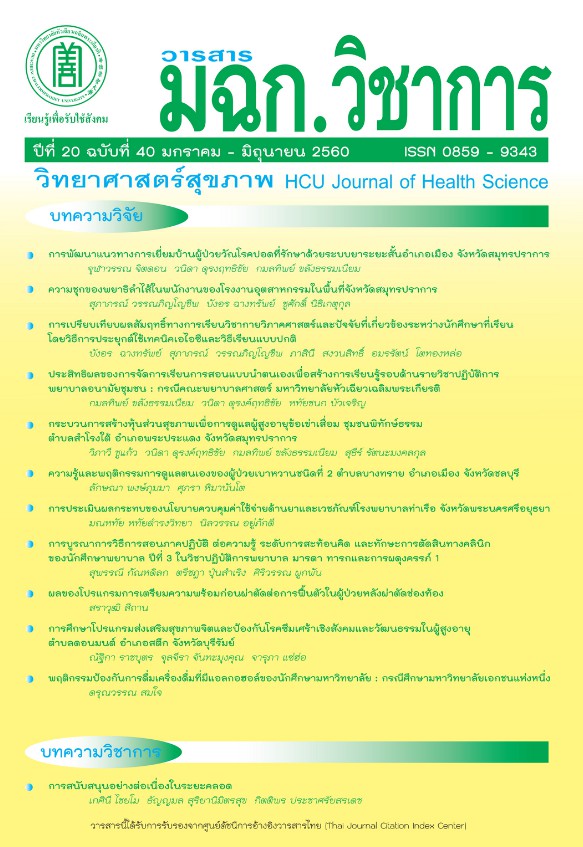The Effectiveness of Self-Directing Learning for Holistic Practice in Communuty Nursing Practicumm Subject : Case Study from Nursing Faculty, Huachiewchalearmprakiet University
Keywords:
Self-directing, learning holistic, practice community nursingAbstract
The objective of a two group experimental research was to study the effectiveness of self-directing learning for holistic practice of nursing students in Community Nursing Practicumm Subject in order to 1) in apply knowledge to practice 2) perceive their capabilities 3) perceive their self-efficacy. 78 nursing students were in an experimental group and 113 nursing students were in a control group. The instrument used was a self-directing learning program and a questionnaire which was validated by experts. The self-directing learning program and the questionnaire were employed (α– coefficient 0.954). The research data were analyzed by percentage, mean, standard deviation, t-test, and paired t-test. The results showed that after applying self-directied learning activities, the control group had the mean score of perception in their capabilities related to applying knowledge significantly higher than the experimental group (¯x 8. 41, S.D. 0.763 , ¯x 7.96, S.D. 1.145) (p=0.001), the mean score of perception in their capabilities in practicum and their self-efficacy non-significantly (¯x 4.16, S.D. 0.414, ¯x 4.23, S.D. 0.436) higher than experimental (¯x 4.05, S.D. 0.420, ¯x 4.14, S.D. 0.410). The mean score of perception in applying knowledge (¯xbefore 7.60, (¯xafter 7.96, p = 0,.005 ), and perceived self-efficacy in practice (¯xbefore 4.05, (¯xafter 3.74, p = 0.000) of the experimental group significantly higher than control group. The mean score of perceived capability in practice (¯xbefore 4.05, (¯xafter 3.74, p = 0.000) of the experimental group significantly lower than the control group.
Downloads
References
child-centered%20education.pdf
Felder RM, Brent R. Active Learning: An Introduction. ASQ Higher Education Brief. 2009;2(4):1-5.
อภิกัญ เลิศวาสนา. รายงานการวิจัยรูปแบบการจัดการเรียนการสอนแบบบูรณาการที่เน้นผู้เรียนมีส่วนร่วมในการเรียนรู้. สมุทรปราการ : วิทยาลัยสารพัดช่างสมุทรปราการ; 2552.
ราชกิจจานุเบกษา. ประกาศกระทรวงศึกษาธิการเรื่อง มาตรฐานคุณวุฒิระดับปริญญาตรี สาขาพยาบาลศาสตร์ พ.ศ.2552. [อินเทอร์เน็ต]. 2553 [เข้าถึงเมื่อ 20 พฤษภาคม 2558]. เข้าถึงจาก:
http://www.mua.go.th/users/he-commission/doc/law/ministry%20law/1-39%20TQF%20nursing%202552.pdf.
Brockett RG, Hiemstra R. A conceptual framework for understanding self-direction in adult learning in Self-Direction in Adult Learning: Perspectives on Theory, Research,
and Practice [Internet]. 1991 [Cited 2015 Oct 11]. Available from: http://www.infed.org/archives/e-texts/hiemstra _self_direction.htm.
Schlesselman JJ, Stolley PD. Case-control studies: design, conduct, analysis. New York : Oxford University Press; 1982.
Khanyile T, Mfidi F. The effect of curricula approaches to the development of the student’s clinical reasoning ability. Curationis. 2005;28(2 May):70-6.
Ranse K, Grealish L. Nursing students’ perceptions of learning in the clinical setting of the dedicated education unit. Journal of Advanced Nursing. 2007, April; 58 (2):171–9.
Downloads
Published
How to Cite
Issue
Section
License
บทความที่ได้รับการตีพิมพ์เป็นลิขสิทธิ์ของวารสารวิทยาศาสตร์สุขภาพและสุขภาวะ
ข้อความที่ปรากฏในบทความแต่ละเรื่องในวารสารวิชาการเล่มนี้เป็นความคิดเห็นส่วนตัวของผู้เขียนแต่ละท่านไม่เกี่ยวข้องกับมหาวิทยาลัยหัวเฉียวเฉลิมพระเกียรติ และคณาจารย์ท่านอื่นๆในมหาวิทยาลัยฯ แต่อย่างใด ความรับผิดชอบองค์ประกอบทั้งหมดของบทความแต่ละเรื่องเป็นของผู้เขียนแต่ละท่าน หากมีความผิดพลาดใดๆ ผู้เขียนแต่ละท่านจะรับผิดชอบบทความของตนเองแต่ผู้เดียว




